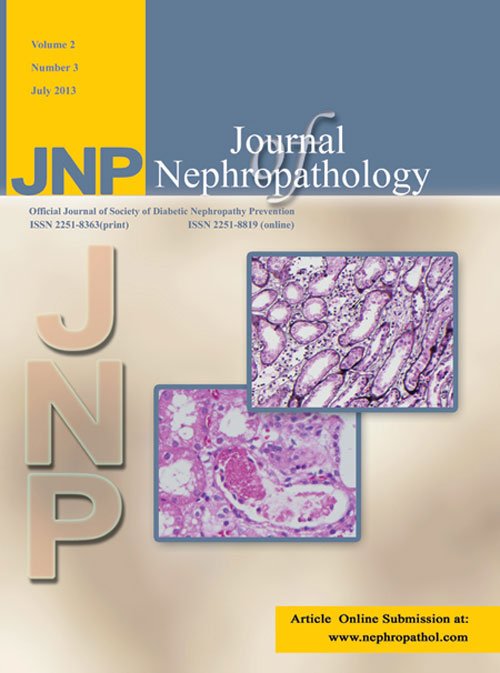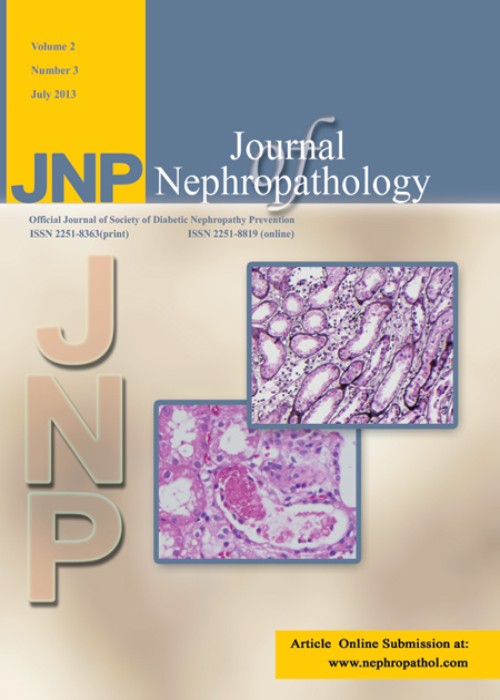فهرست مطالب

Journal of nephropathology
Volume:8 Issue: 4, Oct 2019
- تاریخ انتشار: 1398/08/30
- تعداد عناوین: 12
-
Page 1
Chemotherapy has been accepted as the most common choice for cancer treatment. However, chemotherapy-induced toxicity and chemotherapy resistance are the two challenging barriers to the treatment. Metformin is a safe, inexpensive, and the first line drug to treat type II diabetes. It has also a significant anti-tumor effect with a selective cytotoxic efficacy on cancer stem cells. It also has renoprotective efficacy. The current study contributes to incorporating metformin to chemotherapeutic agents to develop treatment efficiency and reduce the chemotherapy-induced side-effects (such as toxicity and resistance) and also to benefit the nephroprotective impact of this drug.
Keywords: Chemotherapy, Metformin, Cisplatin, Nephroprotection, Reactive oxygen species, Kidneys, Tumor, Nuclear factor (NF)-κB, Cisplatin cytotoxicity -
Page 2Introduction
Peritonitis is the main cause of morbidity and dropout from peritoneal dialysis (PD)
program.ObjectivesWe aimed to determine risk factors predisposing to PD-associated peritonitis.
Patients and MethodsAs a retrospective cohort research, on 235 PD individuals with 4277 patientmonths of follow up, 170 episodes of peritonitis was reported in 93 patients. Data were extracted from medical records using a template. Standard as well as zero-inflated negative binominal regression was used to model the association between patients’ characteristics and the peritonitis rate. Cox-proportional hazard (PH) adjusted model was used to determine the effect of factors on the peritonitis-free survival.
ResultsWith a mean (SD) body mass index (BMI) of 18.7(3.4) kg/m2, 109 (46.4%) of them weremale. With a median (95% CI) follow-up time of 19 (16 to 36) months, the rate of peritonitis was0.48 episode per patient-year. The most common micro-organism detected was coagulase-negativestaphylococci (n=54; 31.7%). The only variable which was associated with a higher rate of peritonitis
was BMI (rate ratio [RR]: 1.07; 95% CI 1.01 to 1.14; P value=0.031). Comparing to patients with lower education, patients with higher than elementary school of education had higher peritonitisfree survival (with hazard ratio [HR]=0.51; 95%CI 0.33-0.79, P value=0.003) and higher chance of having no peritonitis [odds ratio (OR):1.97; 95% CI 1.08 to 3.59; P value=0.029].ConclusionPeritonitis is still a major concern in PD patients. BMI was a risk factor for higher peritonitis rate. Higher education level was associated with lower peritonitis-free survival and higher chance of having no peritonitis.
Keywords: Body mass index, Educational status, Peritoneal dialysis, Peritonitis, Risk factors -
Page 3Introduction
Prostatic cancer is one of the most common malignancies among males. Perineural invasion (PNI) is a common finding of prostate cancer associated with more aggressive malignancies.
ObjectivesThe current study was conducted to assess the association of PNI with serum prostate specific antigen (PSA) and Gleason score.
Patients and MethodsThis analytical cross-sectional study conducted on 354 known cases of prostatic cancer (2015 until 2017). Patients’ last PSA and Gleason score wit h presence/lack of PNI in their prostate biopsies were recorded. The association of PNI with PSA and Gleason score was assessed.
ResultsSerum level of PSA and Gleason core were significantly higher in patients with PNI (P< 0.001 for both). Gleason score was independently a predictor of PNI (odds ratio [OR]: 3.05, 95% CI:2.32- 4.001; P=0.001). Serum PSA level of 17 ng/mL had specificity of 90.3% and sensitivity of 42.7% for prediction of PNI.
ConclusionIn this study we found, Gleason score is independently a prognostic factor of PNI among cases undergone prostate biopsy. In addition, serum PSA level of 17 ng/mL was 90.3% specific and 42.7% sensitive for PNI occurrence. However, our findings require further evaluations by larger studies.
Keywords: Perineural invasion, Prostate specific antigen, Gleason score, Prostate cancer -
Page 4
Anti-neutrophil cytoplasmic antibody (ANCA) disease remains a diagnostic challenge due to the heterogeneity of possible clinical presentations. We present the case of a 63-year-old white male with a known history of ANCA-associated vasculitis (AAV) with anti-myeloperoxidase antibodies (MPO) – mainly with respiratory manifestations – treated with corticosteroids and cyclophosphamide, resulting in partial improvement. Six months later he was referred to the nephrology department for rapidly progressive renal failure and a kidney biopsy was performed, which showed several glomeruli globally sclerosed and others presenting fibrous crescents. Vascular involvement was also noted with several small arteries revealing endothelial swelling and entrapped erythrocytes within a fibrin thrombus. Immunofluorescence was negative. A high percentage of parenchymal fibrosis and no evidence of active extra-renal manifestations dictated no specific treatment. The patient is currently monitored in a low clearance nephrology consultation. Evidence of thrombotic microangiopathy (TMA) is an uncommon histological finding in kidney biopsies of patients with AAV, being associated with worst prognosis.
Keywords: ANCA-associated vasculitis, Kidney biopsy, Prognosis -
Page 5Introduction
Contrast-induced acute kidney injury (CIN-AKI) is a serious complication of coronary angiography. Given the weaknesses in the common protective methods used to prevent CIN-AKI, a safe and effective strategy is needed. RIPC has been shown to have a nephroprotective effect.
ObjectivesWe aimed to determine the protective effect of RIPC on CIN-AKI after angiography or percutaneous coronary intervention (PCI) in low-risk patients.
Patients and MethodsIn our study, 140 low-risk patients who needed angiography or PCI, were assigned to either RIPC or control group. In each group, serum creatinine and urinary neutrophil gelatinaseassociated lipocalin (uNGAL) were measured before the procedure. Serum creatinine was measured daily for 2 days and uNGAL was measured 6 and 24 hours after the procedure. Diagnosis of AKI was,
according to the Kidney Disease; Improving Global Outcomes (KDIGO) criteria (2012).ResultsThe mean age in the remote ischemic preconditioning (RIPC) group was 56.8 ± 11.4 years and 56.3 ± 11.8 years in the control group. We observed no significant difference regarding patient’s characteristic and renal biomarkers at baseline. There was no significant difference in the incidence of AKI (P = 0.116). The uNGAL increased by 36.2% 6-hour after the procedure in patients with AKI, while at the same time, this biomarker increased only by 4.3% in patients without AKI.
ConclusionWe concluded that RIPC, with 3 cycles of 5-minute ischemia and 5-minute reperfusion, did not decrease CIN-AKI or altering renal biomarkers course in low-risk patients undergoing coronary angiography or PCI. Additionally, uNGAL, seems to be an appropriate biomarker for early diagnosis of CIN-AKI, 6 hours after contrast media exposure.
Keywords: Remote ischemic conditioning, Preconditioning, Contrast-induced nephropathy, Acute kidney injury, Coronary angiography, Percutaneous coronary interventio -
Page 6Introduction
5-aminosalicylic acid (5-ASA) compounds have been used in the management of ulcerative colitis for decades. Nephrotoxicity has been previously described in patients treated with 5-ASA compounds and usually manifests as interstitial nephritis, however a few cases of nephrotic syndrome have been reported. Balsalazide is a pro-drug composed of 5-ASA linked to an inert carrier.
Case PresentationHere we report the case of a 74-year-old man with a history of ulcerative proctosigmoiditis treated with balsalazide who presented to our clinic with bilateral lower extremity edema three months after initiation of balsalazide. Laboratory workup showed nephrotic range proteinuria without an apparent secondary etiology. Given worsening proteinuria and renal function despite cessation of balsalazide, the patient underwent renal biopsy that revealed minimal change disease. High dose steroids were started and complete remission of proteinuria was achieved one month into therapy which was slowly tapered over the next five months. Eventual resolution of edema and return of creatinine back to patient’s baseline level was achieved.
ConclusionTo our knowledge, this is the first report of nephrotic syndrome manifesting soon after initiation of balsalazide therapy. Our work highlights the importance of maintaining a high clinical suspicion for nephrotoxicity when using balsalazide.
Keywords: Nephrotic syndrome, Nephrotoxicity, Minimal change disease, Balsalazide, Mesalamine -
Page 8Introduction
Volume overload is a known risk factor for cardiovascular disease and stroke in hemodialysis patients. The use of fibroblast growth factor 23 (FGF23) as a volume overload marker has been validated in multiple studies.
ObjectivesThis is a prospective cross-sectional study considering the association between FGF23 and bioimpedance-measured volume overload in hemodialysis patients.
Patients and MethodsBioimpedance analysis was performed on 43 hemodialysis patients at the end of hemodialysis to evaluate the remaining volume overload and serum FGF23 was measured before hemodialysis.
ResultsThe results indicated no significant correlation between mean serum FGF23 levels and volume overload in hemodialysis patients (P=0.824).
ConclusionAlthough this study did not show any association between volume overload and FGF23, further studies are needed to define the role of FGF23 as a volume overload marker.
Keywords: Fibroblast growth factor 23, Hemodialysis, Volume status, Overload, Bio-impedance analysis, Chronic kidney diseas -
Page 9Introduction
Diabetic nephropathy (DN) is a progressive renal disease characterized by persistent albuminuria that leads to end-stage renal disease in both type 1 diabetes (T1DM) and type 2 diabetes (T2DM) patients. The renin-angiotensin-aldosterone system (RAAS) plays a major role in the onset and progression of DN.
ObjectivesThe present meta-analysis is intended to synthesize evidence on the association between ACE gene insertion and deletion (ACE I/D) polymorphism and the risk of DN.
MethodsPubMed, Scopus, Google Scholar and Embase were searched to retrieve relevant publications. Odds ratios (ORs) with 95% confidence intervals (CIs) were calculated to evaluate the association between ACE I/D polymorphism and DN risk. The Cochrane Q test and I2 statistic were used to detect heterogeneity. To assess between-study heterogeneity, subgroup analysis and sensitivity analysis were performed. Funnel plots and Egger’s test were used to estimate publication bias.
ResultsAround 45 articles (47 studies) with 6124 patients of DN and 2492 T2DM patients (controls) were ultimately considered for meta-analysis. Overall, the ACE I/D polymorphism was associated with DN under three different genetic models (allelic model: OR = 1.34; 95% CI: 1.20- 1.49; P<0.001; dominant model: OR= 1.54; 95% CI: 1.31- 1.81; P<0.001; and recessive model:OR= 1.39; 95% CI: 1.19- 1.63; P<0.001). Significant heterogeneity (I2 > 50%) was present in the analysis for all ethnic groups. Further, there is no evidence for publication bias in this meta-analysis.
ConclusionThe current meta-analysis provided confirmation that the ACE I/D polymorphism is correlated with an increased risk of DN in patients with T2DM and the D allele of ACE I/D was a susceptible factor.
Keywords: Diabetic nephropathy, ACE gene, ID polymorphism, Meta-analysis -
Page 11Introduction
While many cases of cytomegalovirus (CMV) nephropathy have been reported in the literature, isolated CMV glomerulopathy is considered a rare finding.
Case PresentationWe report the case of a CMV-negative recipient of kidney allograft from a CMVpositive donor (D+/R-), the recipient subsequently developed severe nephrotic syndrome secondary to biopsy-proven isolated CMV glomerulopathy.
ConclusionThe patient developed CMV viremia with ganciclovir resistant UL97 mutation. His treatment course was resistant to recommended dose of intravenous ganciclovir, so therapy was changed to foscarnet with resolution of his viremia and reduction in proteinuria.
Keywords: CMV glomerulopathy, CMV viremia, kidney transplant, UL 97 mutation, nephrotic syndrome, proteinuria -
Page 12
Contrast agents are non-biologically active substances required for various diagnostic imaging procedures. Exposure to contrast materials, predispose some patients to renal disturbances entitled as contrast-associated acute kidney injury. Nephropathy of contrast medium is a deterioration of renal function which happens within 24 to 72 hours after iodinated contrast medium injection. Cancer individuals have several risk factors for contrast-associated acute renal failure, consisting of administration of chemotherapy regimen, which are mainly nephrotoxic, presence of diabetes or chronic renal failure, hypertension, taking of non-steroidal anti-inflammatory drugs, simultaneous use of nephrotoxic drugs, aminoglycosides, cisplatin, cyclosporine A or amphotericin B, increases the risk of contrast-associated acute renal failure. Similarly, age more than65 years old and anemia is an independent risk factor for contrast-associated acute kidney injury and also timing of CT within 45 days after last chemotherapy and low fluid intake, as the common risk factors in cancer individuals.
Keywords: Contrast-associated acute kidney injury, malignancy Contrast media, Vasoconstriction, Renal medulla, Oxidative stress, Vacuolization


